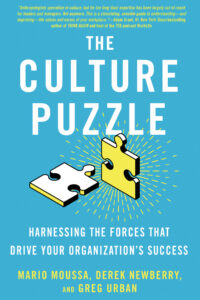Leaders know that culture is often the key to their organization’s success whether they’re trying to enhance employee satisfaction, boost productivity, or launch a new initiative. But all too often, they assume it will take care of itself. Corporate anthropologists Mario Moussa, Derek Newberry, and Greg Urban have a combined 75 years of experience in the field, and I had the opportunity to talk with them about their new book, THE CULTURE PUZZLE; the four forces that shape culture; and how leaders can harness these forces so that their organizations can thrive.
Let’s start with a fundamental question: what is your definition of culture? And what is your view regarding the importance of organizational culture?
Culture is a process of collective learning and adaptation. It’s inherited from the past, the way we do things around here, but it is also about the future, what we’re trying to accomplish, what we’d like to be. It’s dynamic. It’s always working. It’s been working at least since human beings became human beings. It’s in every organization. It’s always on the move. You can’t stand outside of it. As soon as people come together and form a group, a team, a company, a culture has formed. We like to say culture comes first.
In writing THE CULTURE PUZZLE, we went back to social science, and one of the things that we found is that humans are wired to form groups, essentially small groups. Once there’s a group, there’s a culture. In practical terms, what that means is we start asking questions about our purpose, our identity as a group, our way of getting work done, and how to improve what we’re doing.
Culture is important because it shapes everything we do. It shapes how we think about our goals or strategy, our organizational values, how we make decisions big and small, and how we respond to our environment. It’s in all of these respects that culture comes first and that it’s important to organizations.
Why does it create such confusion among many leaders?
Lou Gerstner, the former IBM CEO, once said, “Culture is everything.” That’s true, but that’s exactly what makes it so puzzling. If it’s everything, then how do you get a handle on it? It’s clear that leaders struggle with culture for just this reason. Consider the fact that many CEOs say culture is their top priority but admit they don’t understand it.
We often compare the typical experience of culture to operating a plane on autopilot. We make decisions, and then we barrel ahead into action. Whether we are aware of it or not, however, culture has shaped those decisions.
Organizations have standard ways of operating. That’s OK if everything is working perfectly. But often it’s necessary to slow down and figure out how to do things differently—how to create a different strategy, manage decisions differently, manufacture different products, bring new people into an organization.
It’s hard to do this while you are running a business. That’s why so many organizations fail to do it. That’s why so many great businesses fail or decline. Think Kodak. Think Lehman Brothers. Think of the shifts in the media industry that brought low leading magazines and newspapers. What happened in all of these case is culture got out of sync with the environment.
What are tribes? How does one organization best unify the tribes to a single goal? When should they not do that?
In The Culture Puzzle, we look at organizations through the lens of anthropology. When you do that, you see clearly that people are tribal. We’re social, we’re group-oriented, and we do best in small groups—or tribes. The tribal impulse is built into our bones, because for thousands and thousands of years, we’ve been tribal and it has worked for us.
But for the past 150 years or so, we’ve been working in much bigger and much more complex global corporations. It takes a certain kind of leadership and a certain type of thinking to knit together the pieces of a large, diverse, complex organization. To build a company, leaders need to create a tribe of tribes.
Often, of course, tribes need to do things their own way, too. Finance is different from sales, R&D is different from quality, and so on. Leadership is the art of knowing when to unite different tribes around single vision or idea and when to let tribes do things their own way. Too much emphasis on unity distracts people from details of their jobs and shuts down creativity. Too little creates chaos.
Let’s talk about the four forces: vision, interests, habits, and innovation. How do they work together?
Your organization’s vision should be built on the stories people tell about why your organization exists–in other words, a shared vision. If your company’s vision is going to resonate with your people, they need to be involved in crafting it.
The vision has to resonate with people’s interests. Everyone wants to build a common bond with others, do meaningful work, and feel valued and respected. Look for gaps between what each person and tribe needs to satisfy these interests and what your organization delivers.
Habits provide the structure and cues for the everyday behaviors that define your culture. How are decisions made? Who has the authority to sign off on a budget? How do we run meetings? How often do you check in about your strategy? These are all aspects of organizational habits that should reinforce your culture.
Every culture needs a periodic refresh. That’s where innovation comes in. Look inside your own organization for independent thinkers who are finding creative ways to solve problems. Build pilots out of the ideas you discover, test new ways of getting things done, and learn from them. You might encounter some outlandish ideas, but remember that there’s a reason people are talking about them.
Many in leadership think that vision is solely the job of the CEO or the senior team. I’d love your perspective about vision and why everyone in leadership should consider it part of their role.
The conventional wisdom about vision–that it springs from the head of a lone genius–is a hold-over from the old days of top-down management. Many business experts will tell you that culture starts at the top, where members of the C-suite hold the keys to success. But any anthropologist worth their salt will tell you that culture is everywhere. Everybody holds the keys in their hands: middle managers, the front-line people who do the hard, everyday work to bring products and services to market, all the way down to the folks who wax the floors and clean every surface with disinfectant. It’s a collective power that’s always circulating, shaping every conversation, meeting, and decision.
Interest is another “force.” What characteristics does an organization have when it is doing well in this area?
People are engaged when they feel their interests are being satisfied, and they’re energized, creative, and collaborative.
A strong culture can inspire the sort of intense devotion needed to push people further past their own boundaries than they ever imagined possible. It’s not surprising that “cult” and “culture” share the same Latin root of cultus, which means “cultivation” (in the sense of gardening) but can also mean “adoration.” Such a powerful feeling can propel people to endure the harshest threats and most challenging environments in order to accomplish something they could not do on their own.
Next is habit. When is habit helpful and when is it limiting? How can a leader know which is which?
Collaboration is an ever-developing, fluid process, a process of creating the habits for getting work done and creating a sense of belonging to a group that embraces shared values. The force of habit never stops exerting its influence on us.
That’s fine for good habits, of course. But what about bad habits? Cultures sprout bad habits all the time, producing toxic environments that make it hard to get things done. So, it’s not enough to craft a vision and rally people around it. You need to channel positive energy into ways of working that, day in and day out, reflect and reinforce your culture.
Innovation. Talk a little about innovation in this context.
Human beings have a distinctive knack for inventiveness. Working together, our ancient ancestors devised ways to master their environments more effectively than bigger, stronger, faster animals. In all the generations that followed, people have worked together unceasingly to do things better. Every team does it every day, often without thinking about it, as team members figure out ways to succeed in a challenging, ever-changing environment.
Engage this force by making people feel safe to speak their minds. Listen. Respond. Most innovation happens outside of the formal R&D process. The best ideas grow out of day-to-day work. Create opportunities for sharing those ideas, and testing and scaling them.
Tell us more about the Culture Evaluator and how it can be helpful.
Every organization includes multiple tribes: teams, divisions, units, groups of work buddies, old college friends, task forces, and so on. The conventional organizational chart tells only a small part of the story. Once people come together to form a tribe, culture comes alive and begins to grow and evolve, often creating unproductive conflicts within and between groups.
We have designed the Culture Evaluator to help you assess the health of any culture, from that of a small tribe to one shared by the larger “imagined community.” The Evaluator will reveal which aspects of a culture demand your attention. Does your vision need to be updated? Are people’s interests being satisfied? Do our habits support the way we need to get our work done? Do we have an environment that encourages innovative thinking? In short, what’s working and what’s not working? What do we want to keep of the old culture and what needs to be changed?
It’s good idea to get into the habit of evaluating your culture on a regular basis. The best leaders know when to go fast and when to slow down, take a good look at how things are going, and get everyone on board with making necessary changes. If you’ve created a tribe of tribes, it will be much easier to harness the forces that drive your organization’s success.
For more information, see THE CULTURE PUZZLE.
Image Credit: Edge 2 Edge Media.

